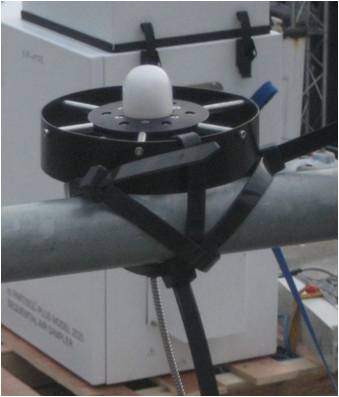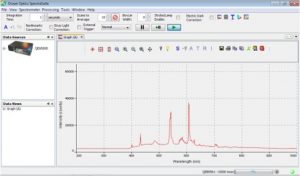Instrument Support Level 2
Ocean Optics QE65000
ncas-spectral-radiometer-1, ncas-spectral-radiometer-3 (aircraft)
solar-actinic-flux
£10,000
18.2 cm x 11 cm x 4.7 cm. 1.2 kg
50 cm x 40 cm x 25 cm. 5 kg
£10
Calendar

Spectral Radiometer
This spectroradiometer provides a direct measurement of solar actinic UV flux and determination of photolysis frequencies. The instrument consists of a 2-pi sr quartz diffuser coupled to an Ocean Optics spectrometer via a 10 m fiber optic cable.
The spectrometer operates between 200 – 1000 nm; it is calibrated 250 – 750 nm (< 1nm resolution). It utilises a Hamamatsu, back-thinned FFT-CCD detector with >90% quantum efficiency at 700 nm. It has an integration time between 8 ms to 15 minutes and fully automated data collection using Spectrasuite software
There are two systems available:
- A single unit for ground-based deployments (ncas-spectral-radiometer-1).
- A pair certified for installation on the FAAM aircraft (ncas-spectral-radiometer-3)
- one upward-looking
- one downward-looking
- Although comprising a pair of radiometers this is a single instrument and can only be booked as such.
The QE65000 features a Hamamatsu back-thinned detector with a 2-D arrangement of pixels (1044 horizontal x 64 vertical) that is responsive from 200-1100 nm. The detector’s columns are binned, or summed, inside the detector prior to the readout process, thereby minimizing readout noise. Additionally, the detector can be cooled down to –15 ºC with the onboard TE-Cooler to reduce dark noise. The reduction of noise and dark signal allows integration times of the spectrometer (analogous to the shutter speed of a camera) of up to 15 minutes, which greatly enhances the detection limit in low-light-level applications. The back-illuminated detector has a great response in the UV.
The combination of the spectrometer’s low-noise detector and 16-bit A/D Converter delivers a dynamic range of 25000:1 and a signal-to-noise ratio of 1000:1.
The QE65000’s onboard module has 10 user-programmable digital I/O lines for interfacing to other equipment; and a pulse generator for triggering other devices. You can use the I/Os to flash a lamp, stop/start a process, and send a message/alarm during the spectrometer’s integration period. The spectrometer’s operating parameters can be controlled through software. In fact, wavelength calibration coefficients unique to each spectrometer are programmed into a memory chip right on the spectrometer.
TheQE65000’s high-speed electronics have been designed for considerable flexibility in connecting to various modules and external interfaces, including PCs, PLCs, and other embedded controllers, through USB 2.0 or RS-232 communications. Its USB 2.0 interface enables full spectral scans into memory every 7 milliseconds.
The QE65000 operates via a USB interface. A +5 VDC external power supply is required for the TE Cooler (TEC) and to operate the spectrometer via an RS-232 interface. This power supply is included with your spectrometer.
The instrument is calibrated directly before and after deployment against a 1000 Watt (FEL) quartz-halogen tungsten coiled-coil filament lamp Standard of Spectral Irradiance (OL FEL-A) supplied by Gooch and Housego and bears the designation F-1128.
Calibration of Standard F-1128 was performed by direct comparison to a Gooch and Housego NIST traceable FEL 1000-Watt lamp Standard of Spectral Irradiance, S/N: F-1002.
Calibrated over the range 250 – 750 nm.
Costs
- Instrument Insurance:
- This system must be insured by the user for £50K and covers loss, theft or damage to the instrument: damage is that over and above general wear and tear.
- The system has been designed to be rugged and autonomous. Even so, the end-user must respect the fact that the system is a precision optical instrument that must be treated with great care.
- The user is responsible for the instrument from the time it leaves the AMF to the time it is returned and signed off as in an acceptable operating condition by the IS: this will be done as soon as is possible on its return.
- Public Liability Insurance
- The AMOF is not liable for any damage or injury arising from the deployment or operation of this instrument when unattended by the IS.
- Shipping Expenses
- The user is liable for all costs arising from the shipping of the instrument both to and from deployment.
- IS T&S
- The user is responsible for coving the travel and subsistence expenses of the IS while attending the instrument.
- The user is responsible for covering the travel and subsistence expenses of the IS during mobilisation and demobilisation at the FAAM base of operations at Cranfield.
- T&S during a campaign are negotiated by FAAM.
Shipping
The system when packed ready for shipping consists of a single box:
- Shipping dimensions: 50 cm (L) x 40 cm (D) x 25 cm (H)
- Shipping weight: 5 kg
The spectroradiometer is connected to a 2 pi quartz diffuser via a 10 m fiber optic cable. The 2 pi quartz diffuser should be located in full sun-light (no shading) and positioned horizontally to the horizon. The spectroradiometer and dedicated laptop should be located indoors.
Manual handling
- Care to be taken when removing protective foam covering from around the 2 pi quartz dome to minimise the risk of glass cuts. Cables and fiber kept away from pathways; held overhead height if necessary. Walkways kept free of clutter and access to exit kept clear.
Electric safety
- Check spectrometer casing/laptop casing/cables are in good condition before switching on. Attach all cables to the spectrometer and laptop before switching on at the mains. Under no circumstances should any attempt be made to open up the main body of the instrument. All equipment electrical safety tested.
Attended operation:
- There is no requirement for the system to be attended during operation from a safety standpoint.
COSHH
- Not applicable.
When unpacked the instrument has the following physical specification
Spectrometer Footprint
- 182 mm (L) x 110 mm (W) x 47 mm (H)
Weight (not including shipping case)
- 1.2 kg
Power
- 500 mAmps at 5VDC
Operation temperature
- 0 min°C to 50 max°C
The spectral radiometer provides a measurement of solar actinic flux which can be used to derive photolysis frequencies for any species with published absorption cross-sections and quantum yields.
Field Data
- The instrument produces a range of out files and all are text format.
- The user can download (but not delete) this data from the instrument but it should be noted that this data will not have been quality controlled.

Archive data
- Data is provided in NetCDF files following the AMOF data standard
- Files contain no more than 24hr of data.
- Instrument name is
- ncas-spectral-radiometer-1
- ncas-spectral-radiometer-3 (aircraft)
- The data product(s) associated with this instrument:
- Example data file
